With the advancement of artificial intelligence, more people are observing how it can transform the way we communicate and interact with the world. This includes digital marketers! If you have not heard the commotion about the latest technological development in the AI space, it’s time to pay VERY close attention.
ChatGPT has entered the chat.
This AI tool is disrupting the way people work and is revolutionizing content creation and strategy planning for digital marketers.
What is ChatGPT?
ChatGPT is a language chatbot developed by OpenAI that generates human-like responses in real time for a given prompt. This can be used for business-related items like customer service, writing ad copy, and research. OpenAI used massive amounts of data in order for ChatGPT to accurately predict what word comes next in a sentence.
Chat GPT & PPC Use Cases
Now, onto the most exciting part of the blog post. We’re going to explore how you can use ChatGPT to your advantage with Google Ads PPC.
We’ve uncovered 6 of the most practical use cases for PPC marketers to leverage AI to their advantage to level up and move quicker in the campaign planning and development process:
1. Keyword Suggestions
ChatGPT can quickly pull a list of keywords to get you started with the planning phase of your campaign. While ChatGPT cannot provide real-time search volume data in specific geographic areas or competition levels that you would typically get in the Google Keyword Planner, it can still help generate a quick list of keyword suggestions to get you started in the campaign planning process.
The tool is extremely helpful when it comes to generating synonyms and new keyword ideas when you’re stuck!
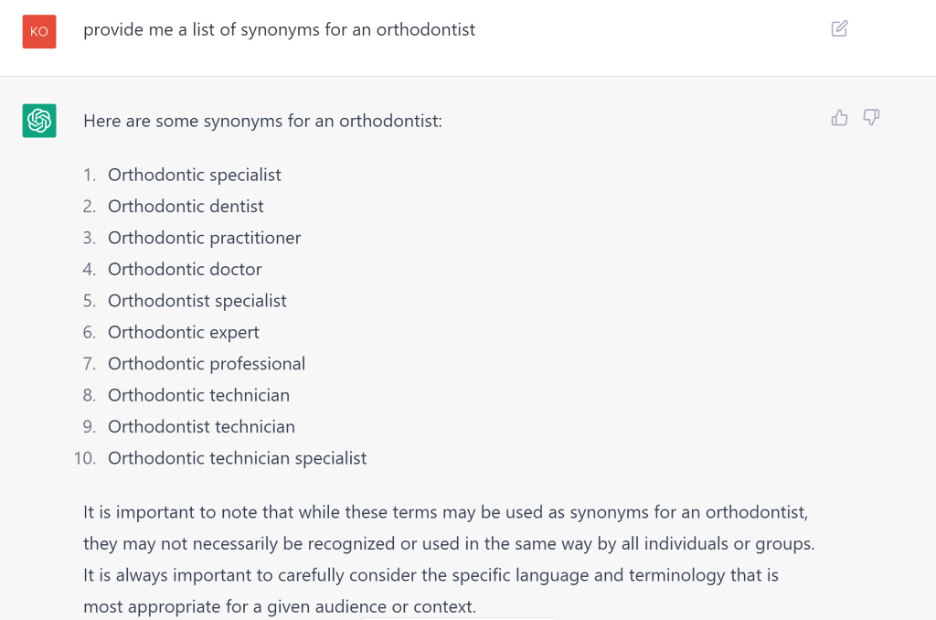
2. Creating a Customer Persona
When creating a PPC campaign, it’s critical that you know your customer persona. And for some businesses, multiple customer personas are needed. You’ll want to understand your customer persona’s needs, pain points, household income, demographics, etc.
Using the orthodontist example from our previous section, let’s take a look at who would be potential patients for an orthodontist:
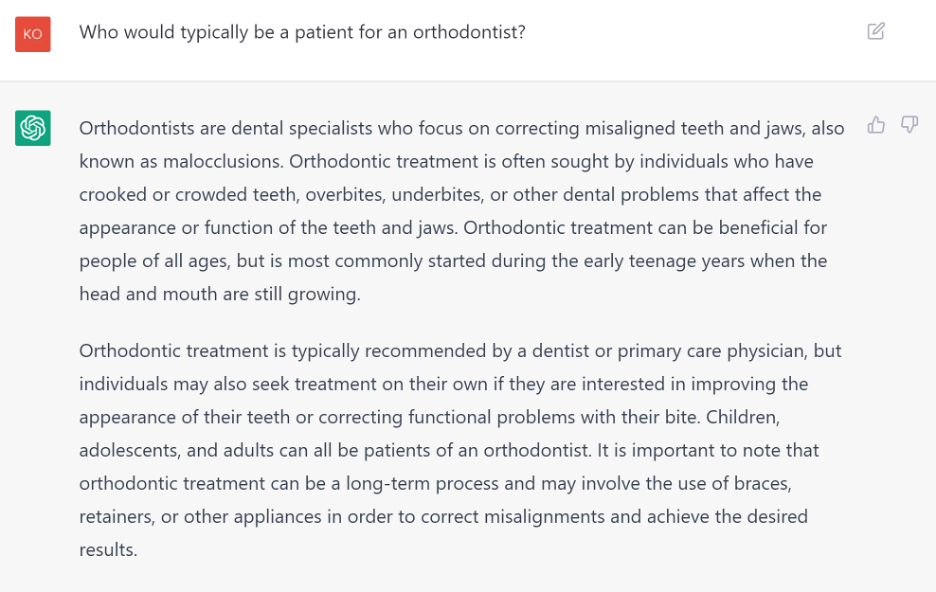
Notice how ChatGPT mentions that orthodontic treatment is beneficial for people of all ages but that it’s commonly started during early teenage years. This can give us clues about who to target. In this specific example, we may not want to exclude any age demographics but put more emphasis on parents of children and teens.
3. Identify the Best Cities to Target
Sure, you may already know the service areas you want to attract new business from but from the orthodontist example, what if this orthodontist only offered private-pay services and did not accept insurance?
Then the PPC strategy would change and you would want to be smarter about the cities you target to only attract those who would be willing to pay around $6K out-of-pocket for orthodontic treatment. This use case is great if you are looking to target higher-income demographics and those living in cities with high household incomes.
Remember, you need to be specific in order for ChatGPT to provide the best output. In this example, the prompt was very specific – asking for affluent cities with average household income by city and it delivered (along with a few caveats).

Based on this information, you can decide how you want to organize your campaigns for the best possible results.
4. Competitor Research
Tell ChatGPT to find competitors to a specific business in a specific area.
This one is a hit or miss and has worked for some niches sometimes but could still be worthwhile to try out. It’s nowhere near a SpyFu or Semrush but see how it works for you!
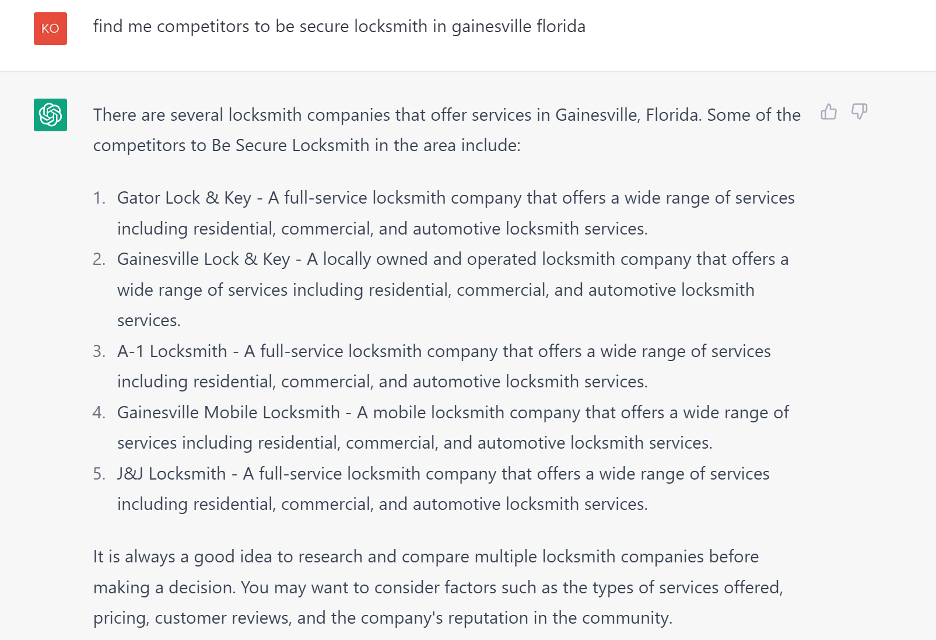
After identifying some competitors, you can do your own research to see if they are advertising. See if you can glean anything from their online marketing presence or strategy.
5. Ad Copy Creation
One of the most efficient ways to use ChatGPT is to generate ideas for headlines and descriptions in your Responsive Search Ads. You will need to provide specific instructions, such as: Create ad copy that targets commercial roof customers and persuade them to contact a roofing company.
See below for what ChatGPT generated:
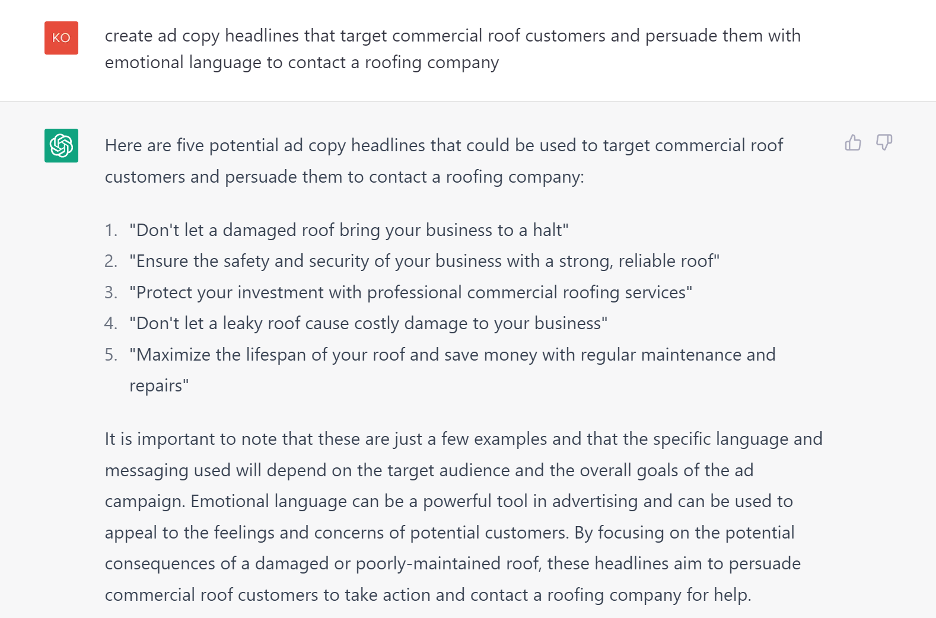
Do those descriptions seem a little too long for Google’s 30-character headline limit? It’s because they are!
One important thing to note is that ChatGPT is not yet robust enough to align with Google’s character restrictions, so your headlines and descriptions will not usually meet the character requirements. However, that isn’t a bad thing! It’s critical that you take these suggestions and make them your own to avoid plagiarism.
6. Generate Landing Page Content
Your landing page copy is just as important as your Responsive Search Ads. Once you drive qualified traffic to your landing page, they still need to be persuaded to take action and become a lead.
The landing page content should be persuasive and in a tone that speaks to the customer’s pain points. In this case, ChatGPT was asked to produce an emotional and compelling copy – remember to always address pain points!
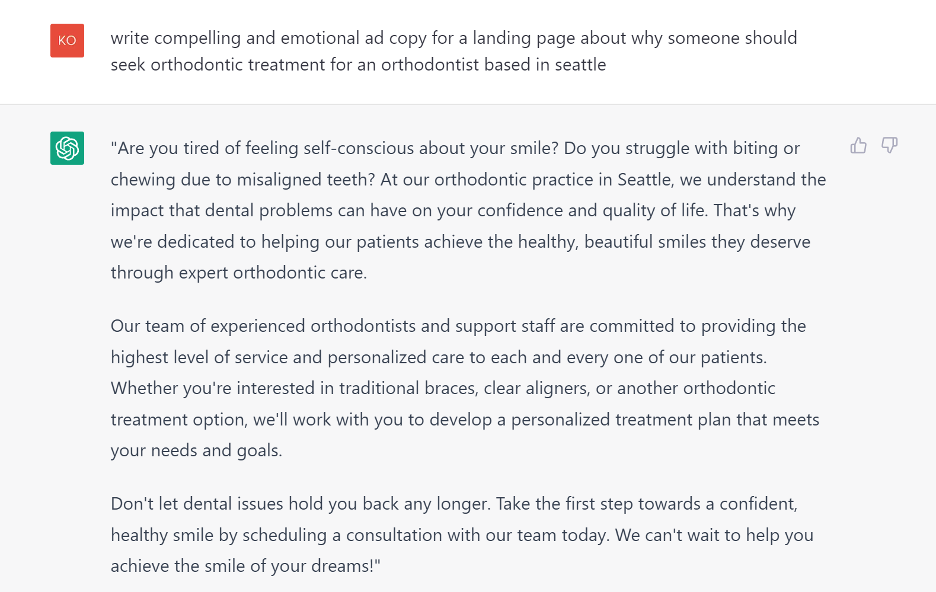
Great elements of this ChatGPT copy include the call-to-action, the questions that address the patient’s pain point being self-conscious and biting with misaligned teeth, and speaking to unique value propositions.
An additional idea for ChatGPT in regards to using it to create content for your landing page is to use it to come up with common objections a potential customer would use. In the below prompt, ChatGPT was asked why someone would avoid orthodontic treatment and ChatGPT was able to give reasons and these are all great objections to tackle on the landing page:
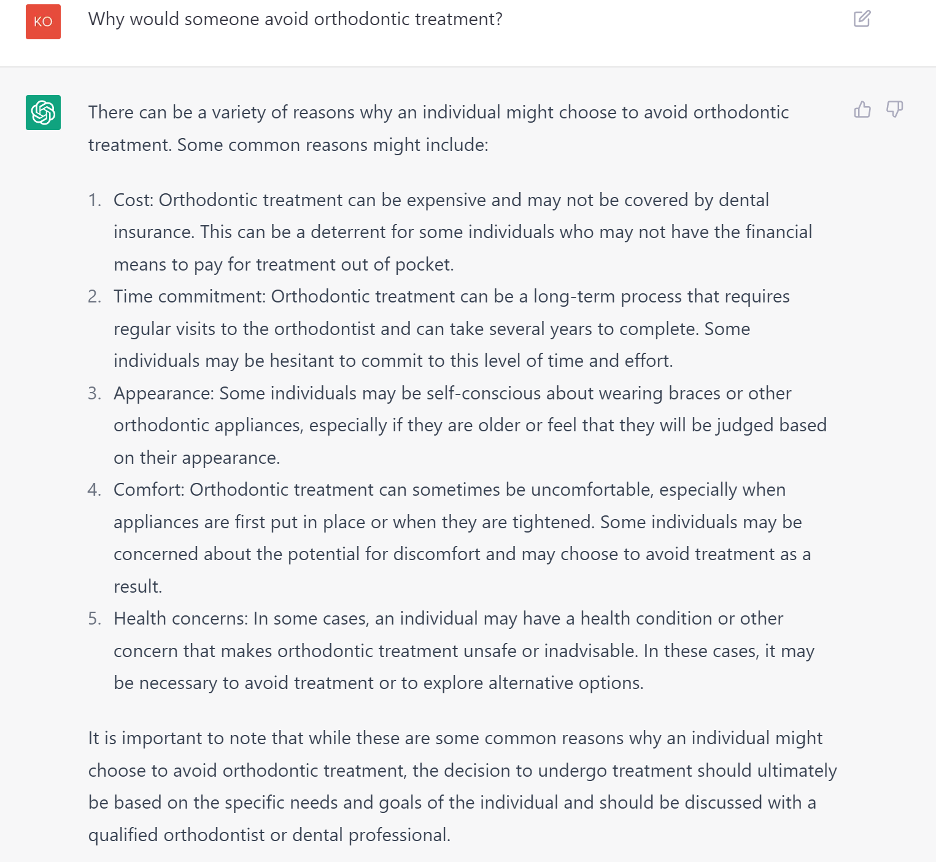
Based on the info above, you could create a special FAQ section on the landing page or just plan to address these points throughout the landing page.
A Little Side Note About ChatGPT:
When using content generated by ChatGPT, be sure to make it your own. You can use it as a point of inspiration when you have a creative roadblock or are looking for a place to start. Don’t just copy and paste it as duplicate content can have some negative consequences.
Limitations of ChatGPT
ChatGPT can provide high-quality responses, but only if you have very specific instructions. OpenAI notes that ChatGPT can produce “plausible-sounding but incorrect or nonsensical answers”, so users must keep this in mind and not deem every answer 100% accurate. The model will also have certain biases based on the training data that is used. Also, keep in mind that ChatGPT does not have knowledge of current events to give you answers based on anything that happened prior to 2022.
ChatGPT is still an incredibly powerful tool that can help marketers streamline workflow, increase efficiency, and remove creative roadblocks.
If We Have ChatGPT, Do We Need Marketers?
With all of these great ways that ChatGPT can help streamline the campaign research and ad copy process, you might be wondering if we even need marketers and PPC specialists. As mentioned, ChatGPT still has its limitations and cannot completely displace marketers. You still need a solid PPC foundation in order to properly implement any strategy and monitor success. Plus, you need to be able to understand how to tie in the real world with ChatGPT in order to use it to your advantage.
AI models and ChatGPT can be great tools to use in conjunction with a well-designed PPC strategy.
Need help with creating an effective PPC strategy and generating more leads? Contact Level 28 Media for a free discovery call!

Michelle Kop is a marketing consultant and award-winning pay-per-click marketing strategist. She has over 8 years of professional paid advertising experience in Google and Microsoft Ads, with a specialization in lead generation for B2B and B2C companies.
After working in corporate marketing with Fortune Global 500 Brands like Toyota and BP, Michelle founded Level 28 Media, a lead generation micro-agency for small to medium businesses.


